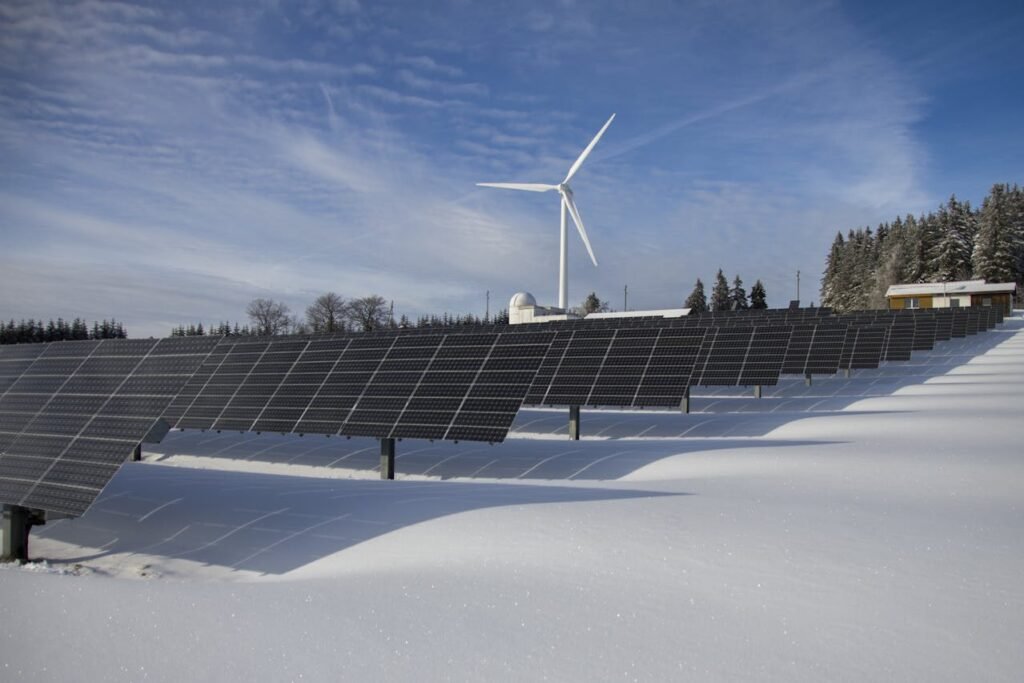Across more than 2,000 scientific studies, a sweeping review concluded that human activities – especially fossil fuel combustion, habitat destruction, pollution, and land‑use change – are eroding biodiversity at a global scale, threatening species in every ecosystem on Earth. Scientists estimate that up to one‑third of all animals and plants could disappear entirely within the next fifty years if fossil fuel–driven climate change goes unchecked. Climate change accelerates direct threats such as extreme weather, droughts, storms, and shifts in habitat suitability. For many species, especially in the tropics and coastal zones, these changes represent existential risks. The urgent imperative for biodiversity protection and climate mitigation is therefore inherently intertwined.
Clean energy — solar, wind, hydro, geothermal, and modern bioenergy — plays a central role in reducing greenhouse gas emissions. According to United Nations projections, about one‑third of global emissions reductions needed over the next decade could come from conserving and restoring natural spaces that absorb carbon, combined with shifts to low‑carbon energy systems. A report by WWF found that a rapid transition to renewables could result in 75 % lower risk of biodiversity loss, 30 % less land needing active mining, and 50 % less land degradation overall compared to business‑as‑usual fossil fuel expansion. In short: decarbonization is one of biodiversity’s strongest natural allies.

Case Studies: Where Clean Energy Supports Nature
In South Africa, the Buffelsdraai Landfill Site Community Reforestation Project restored local forest habitat, sequestered tens of thousands of tons of carbon, and bolstered biodiversity while offering jobs for nearby communities. Though not an energy project per se, it shows how nature‑based carbon solutions paired with clean‑energy thinking deliver multiple wins for biodiversity and people.
In Australia, The Guardian reported that ecologist Emma Bennett led trials showing that raising the wind turbine cut-in speed—the minimum wind speed at which turbines operate—from 3 to 4.5 m/s reduced bat fatalities by 54%, with almost no loss in revenue or energy output. That evidence‑based adjustment shows how clean energy can be deployed with safeguards for wildlife.
According to a report by Reuters.com, the UK government’s Environment Act 2021 now requires renewable energy developments to deliver a legal minimum of 10% biodiversity net gain (BNG), either on-site or through offsets. Developers such as NatPower UK have pledged much higher increases—up to 100%—by creating nature reserves, wildflower meadows, and wetlands on or near wind and solar sites. These additional investments in nature help avoid public opposition, reduce planning delays, and transform clean energy projects into valuable community and habitat assets.
In Canada, analysts found that over 25 % of prime wind and solar lands overlap with unprotected biodiversity hotspots, and 40 % of planned capacity lies in those zones. But by proactively screening and siting projects away from vulnerable habitats, planners could avoid conflict without significant cost. This shows how responsible design links clean energy deployment with biodiversity preservation.
Evidence Map: Studies Confirm Co‑Benefits and Caveats
A recent global evidence map reviewed more than 257,000 research articles on “natural climate solutions” — ecosystem‑based actions that reduce emissions while supporting biodiversity and human well‑being. The map shows that some methods (e.g. restoration, reforestation, peatland protection) deliver strong co‑benefits, whereas others (e.g. bioenergy plantations, large hydropower dams) can pose risks unless carefully managed.
Table: Examples of renewable technologies, potential biodiversity co‑impacts, and mitigation approaches
| Technology | Co‑benefits for Biodiversity | Potential Risks | Mitigations in Practice |
|---|---|---|---|
| Solar power (ground farms) | Can host pollinator habitat, enhance farmland yield | Habitat loss for local fauna, land‑use conflicts | Pollinator‑friendly planting, dual land use |
| Offshore wind | Artificial reefs, new marine habitat | Local change in productivity or bird/bat collisions | Curtain reefs projects (e.g. oysters), ecology monitoring |
| Onshore wind | Replaces fossil extraction areas | Bird and bat mortality during operation | Mixed agroforestry, avoiding the conversion of wild habitat |
| Hydropower | Low‑carbon electricity | River habitat fragmentation, fish migration blocked | Small‑scale run‑of‑river designs, fish ladders |
| Bioenergy | Biomass from residues may support landscape diversity | Monoculture energy crops, land conversion | Mixed agroforestry, avoiding conversion of wild habitat |
Experts emphasize that while clean energy has powerful advantages over fossil fuels, each technology’s ecological footprint varies by context. A special issue in Biological Conservation stresses that interdisciplinary collaboration — energy experts working alongside wildlife scientists, land managers, and communities — is crucial to avoid unintended biodiversity harm during energy transitions.

Expert Voices and Research Highlights
Katherine Hayhoe, chief scientist at The Nature Conservancy, recently argued that climate change doesn’t create new hazards so much as intensify existing ones. She called for stronger preparation, more data, and integrated planning across climate and biodiversity agendas.
Mads Nipper, CEO of Ørsted (a global leader in offshore wind), highlights in a Time.com report that biodiversity actions must be integrated into energy transitions. Ørsted’s BioReef initiative uses oysters and mussels to rebuild reefs beneath turbine foundations—restoring marine life while helping stabilize coastal ecosystems.
A World Wildlife Fund (WWF) report showed that a system powered by renewables performs 2 to 16 times better across metrics affecting nature and people, compared to fossil‑fuel systems, because renewables mean cleaner air and water, less habitat destruction, and lower pollution burdens. Likewise, IEA projections for 2025 indicate $2.2 trillion in global clean energy investment—double spending on fossil fuels—pointing to a shifting economic equilibrium in favour of nature‑positive energy systems.
Conclusion: Actionable Advice for Maintaining Biodiversity as We Power the Future
Transitioning to clean energy is one of the most effective levers available to reduce the climate pressures driving biodiversity collapse. Yet the path forward demands responsibility, planning and collaboration.
First, energy planners and governments must screen projects early, avoiding biodiversity hotspots, conserving migration corridors, and minimizing habitat disruption. Siting innovation matters as much as technology choice.
Second, to amplify benefits, clean energy facilities should integrate biodiversity enhancements—pollinator planting at solar farms, wetland creation, native species corridors, even artificial reefs offshore. The UK’s push for biodiversity net gain and NatPower’s double‑uplift goals show how investors can deliver nature benefits while delivering power.
Third, adaptive management must be standard: monitor wildlife impacts (e.g. bird and bat mortality) and implement adjustments like curtailment when needed. Emma Bennett’s wind‑speed intervention shows how small tweaks yield big wildlife wins.
Fourth, policy must drive fossil fuel phase‑out: clean energy growth alone may not automatically reduce fossil extraction, as a study in the U.S. found. Direct policies — carbon pricing, production caps, reserve‑in‑the‑ground mandates — are needed to ensure renewables actually replace fossil fuels.
Fifth, funders and companies need to commit to combined climate‑nature outcomes, not just energy output. The evidence map from natural climate solutions shows that ecosystem co‑benefits often exceed carbon returns when nature is placed at the centre of planning.
Finally, community and Indigenous involvement should not be optional: local ecological knowledge often reveals sensitive species or habitats, and inclusive planning builds trust and social license.
By scaling clean energy — but crucially, by doing it with biodiversity in mind — we not only slow climate chaos but help nature recover. The result is energy security, healthier ecosystems, and a more resilient future for all species, including our own.







